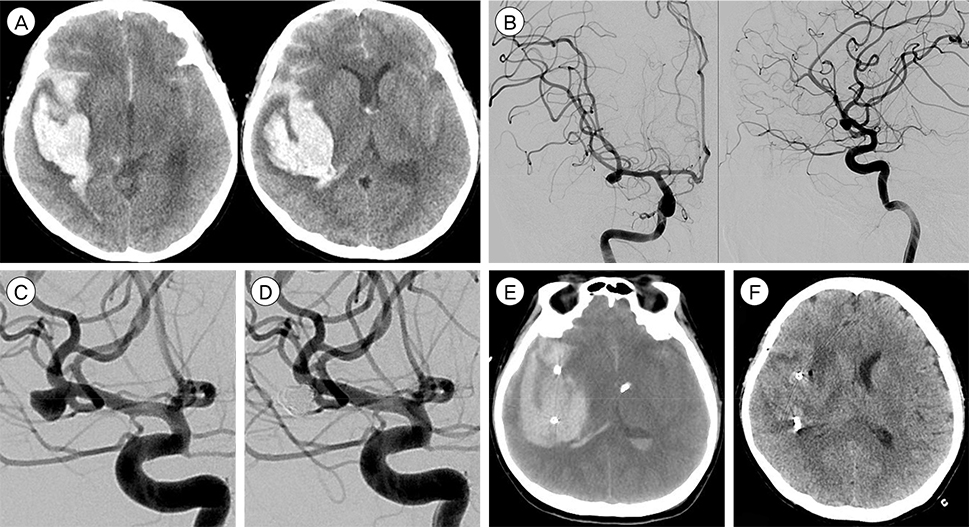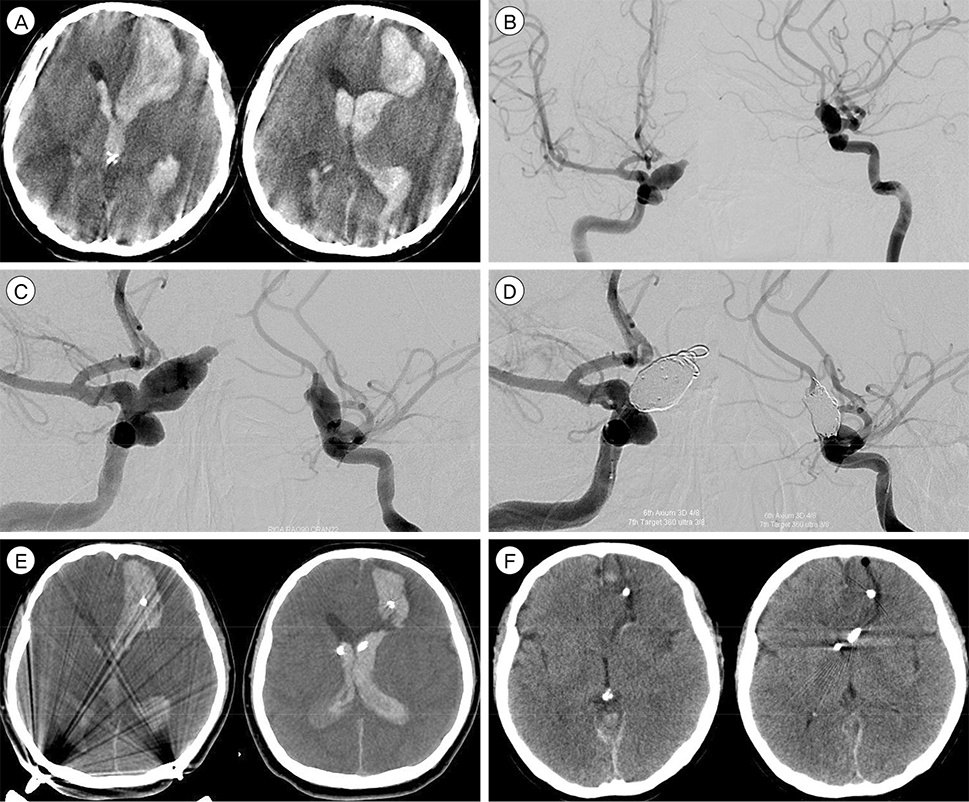J Cerebrovasc Endovasc Neurosurg.
2017 Jun;19(2):81-91. 10.7461/jcen.2017.19.2.81.
A Less Invasive Strategy for Ruptured Cerebral Aneurysms with Intracerebral Hematomas: Endovascular Coil Embolization Followed by Stereotactic Aspiration of Hematomas Using Urokinase
- Affiliations
-
- 1Department of Neuroradiology, CHA Bundang Medical Center, CHA University School of Medicine, Seongnam, Korea.
- 2Department of Neurosurgery, CHA Bundang Medical Center, CHA University School of Medicine, Seongnam, Korea. tgkim@chamc.co.kr
- 3Department of Neurosurgery, Seoul Medical Center, Seoul, Korea.
- KMID: 2393384
- DOI: http://doi.org/10.7461/jcen.2017.19.2.81
Abstract
OBJECTIVE
Aneurysm clipping and simultaneous hematoma evacuation through open craniotomy is traditionally recommended for ruptured cerebral aneurysms accompanied by intracerebral or intrasylvian hemorrhages. We report our experience of adapting a less invasive treatment strategy in poor-grade patients with intracerebral or intrasylvian hemorrhages associated with ruptured cerebral aneurysms, where the associated ruptured cerebral aneurysms were managed by endovascular coil embolization, followed by stereotactic aspiration of hematomas (SRH) using urokinase.
MATERIALS AND METHODS
We retrospectively analyzed 112 patients with ruptured cerebral aneurysms. There were accompanying intracerebral or intrasylvian hemorrhages in 36 patients (32.1%). The most common site for these ruptured aneurysms was the middle cerebral artery (MCA) (n = 15; 41.6%). Endovascular coil embolization followed by SRH using urokinase was performed in 9 patients (25%).
RESULTS
In these 9 patients, the most common site of aneurysms was the MCA (n = 3; 33.4%); the hematoma volume ranged from 19.24 to 61.68 mL. Four patients who were World Federation of Neurological Surgeons (WFNS) grade-IV on admission, achieved favorable outcomes (Glasgow Outcome Score [GOS] 4 or 5) at 6-months postoperatively. In the five patients who were WFNS grade-V on admission, one achieved a favorable outcome, whereas 4 achieved GOS scores of 2 or 3, 6-months postoperatively. There was no mortality.
CONCLUSION
If immediate hematoma evacuation is not mandated by clinical or radiological signs of brain herniation, a less invasive strategy, such as endovascular coil embolization followed by SRH using urokinase, may be a good alternative in poor-grade patients with intracerebral or intrasylvian hemorrhages associated with ruptured cerebral aneurysms.
Keyword
MeSH Terms
Figure
Reference
-
1. Abbed KM, Ogilvy CS. Intracerebral hematoma from aneurysm rupture. Neurosurg Focus. 2003; 10. 15(4):E4.
Article2. Altumbabic M, Peeling J, Del Bigio MR. Intracerebral hemorrhage in the rat: effects of hematoma aspiration. Stroke. 1998; 09. 29(9):1917–1922. discussion 1922-3.3. Auer LM, Deinsberger W, Niederkorn K, Gell G, Kleinert R, Schneider G, et al. Endoscopic surgery versus medical treatment for spontaneous intracerebral hematoma: a randomized study. J Neurosurg. 1989; 04. 70(4):530–535.
Article4. Baskaya MK, Menendez JA, Yuceer N, Polin RS, Nanda A. Results of surgical treatment of intrasylvian hematomas due to ruptured intracranial aneurysms. Clin Neurol Neurosurg. 2001; 04. 103(1):23–28.5. Batjer HH, Reisch JS, Allen BC, Plaizier LJ, Su CJ. Failure of surgery to improve outcome in hypertensive putaminal hemorrhage. A prospective randomized trial. Arch Neurol. 1990; 10. 47(10):1103–1106.6. Bohnstedt BN, Nguyen HS, Kulwin CG, Shoja MM, Helbig GM, Leipzig TJ, et al. Outcomes for clip ligation and hematoma evacuation associated with 102 patients with ruptured middle cerebral artery aneurysms. World Neurosurg. 2013; Sep-Oct. 80(3-4):335–341.
Article7. Broderick JP, Brott TG, Duldner JE, Tomsick T, Huster G. Volume of intracerebral hemorrhage. A powerful and easy-to-use predictor of 30-day mortality. Stroke. 1993; 07. 24(7):987–993.
Article8. Brott T, Mandybur TI. Case-control study of clinical outcome after aneurysmal subarachnoid hemorrhage. Neurosurgery. 1986; 12. 19(6):891–895.
Article9. Chung J, Kim BM, Shin YS, Lim YC, Park SK. Treatment of ruptured anterior communicating artery aneurysm accompanying intracerebral hematomas: endovascular coiling followed by hematoma evacuation with burr hole trephination and catheterization. Acta Neurochir (Wien). 2009; 08. 151(8):917–923. discussion 923.
Article10. Crompton MR. Intracerebral haematoma complicating ruptured cerebral berry aneurysm. J Neurol Neurosurg Psychiatry. 1962; 11. 25:378–386.
Article11. Doi E, Moriwaki H, Komai N, Iwamoto M. Stereotactic evacuation of intracerebral hematomas. Neurol Med Chir (Tokyo). 1982; 06. 22(6):461–467.
Article12. Fayad PB, Awad IA. Surgery for intracerebral hemorrhage. Neurology. 1998; 09. 51:3 Suppl 3. S69–S73.
Article13. Guresir E, Beck J, Vatter H, Setzer M, Gerlach R, Seifert V, et al. Subarachnoid hemorrhage and intracerebral hematoma: incidence, prognostic factors, and outcome. Neurosurgery. 2008; 12. 63(6):1088–1093. discussion 1093-4.14. Hankey GJ, Hon C. Surgery for primary intracerebral hemorrhage: is it safe and effective? A systematic review of case series and randomized trials. Stroke. 1997; 11. 28(11):2126–2132.15. Hauerberg J, Eskesen V, Rosenorn J. The prognostic significance of intracerebral haematoma as shown on CT scanning after aneurysmal subarachnoid haemorrhage. Br J Neurosurg. 1994; 8(3):333–339.
Article16. Heiskanen O, Poranen A, Kuurne T, Valtonen S, Kaste M. Acute surgery for intracerebral haematomas caused by rupture of an intracranial arterial aneurysm. A prospective randomized study. Acta Neurochir (Wien). 1988; 01. 90(3-4):81–83.17. Hondo H, Uno M, Sasaki K, Ebisudani D, Shichijo F, Toth Z, et al. Computed tomography controlled aspiration surgery for hypertensive intracerebral hemorrhage. Experience of more than 400 cases. Stereotact Funct Neurosurg. 1990; 54-55:432–437.18. Hunt WE, Hess RM. Surgical risk as related to time of intervention in the repair of intracranial aneurysms. J Neurosurg. 1968; 01. 28(1):14–20.
Article19. Inagawa T, Hirano A. Ruptured intracranial aneurysms: an autopsy study of 133 patients. Surg Neurol. 1990; 02. 33(2):117–123.
Article20. Jennett B, Bond M. Assessment of outcome after severe brain damage. Lancet. 1975; 03. 1(7905):480–484.21. Jeong JH, Koh JS, Kim EJ. A less invasive approach for ruptured aneurysm with intracranial hematoma: coil embolization followed by clot evacuation. Korean J Radiol. 2007; Jan-Feb. 8(1):2–8.
Article22. Juvela S, Heiskanen O, Poranen A, Valtonen S, Kuurne T, Kaste M, et al. The treatment of spontaneous intracerebral hemorrhage. A prospective randomized trial of surgical and conservative treatment. J Neurosurg. 1989; 05. 70(5):755–758.23. Kim SH, Yoon SM, Shim JJ, Bae HG. Coil embolization of aneurysm followed by stereotactic aspiration of hematoma in a patient with anterior communicating artery aneurysm presenting with SAH and ICH. J Korean Neurosurg Soc. 2008; 01. 43(1):41–44.
Article24. Kothari RU, Brott T, Broderick JP, Barsan WG, Sauerbeck LR, Zuccarello M, et al. The ABCs of measuring intracerebral hemorrhage volumes. Stroke. 1996; 08. 27(8):1304–1305.
Article25. Laidlaw JD, Siu KH. Poor-grade aneurysmal subarachnoid hemorrhage: outcome after treatment with urgent surgery. Neurosurgery. 2003; 12. 53(6):1275–1280. discussion 1280-2.
Article26. Lippitz BE, Mayfrank L, Spetzger U, Warnke JP, Bertalanffy H, Gilsbach JM. Lysis of basal ganglia haematoma with recombinant tissue plasminogen activator (rtPA) after stereotactic aspiration: initial results. Acta Neurochir (Wien). 1994; 127(3-4):157–160.
Article27. Lisk DR, Pasteur W, Rhoades H, Putnam RD, Grotta JC. Early presentation of hemispheric intracerebral hemorrhage: prediction of outcome and guidelines for treatment allocation. Neurology. 1994; 01. 44(1):133–139.
Article28. Locksley HB. Natural history of subarachnoid hemorrhage, intracranial aneurysms and arteriovenous malformations. J Neurosurg. 1966; 09. 25(3):321–368.
Article29. Matsumoto K, Hondo H. CT-guided stereotaxic evacuation of hypertensive intracerebral hematomas. J Neurosurg. 1984; 09. 61(3):440–448.
Article30. Miller DW, Barnett GH, Kormos DW, Steiner CP. Stereotactically guided thrombolysis of deep cerebral hemorrhage: preliminary results. Cleve Clin J Med. 1993; Jul-Aug. 60(4):321–324.
Article31. Modesti LM, Binet EF. Value of computed tomography in the diagnosis and management of subarachnoid hemorrhage. Neurosurgery. 1978; Sep-Oct. 3(2):151–156.
Article32. Mohadjer M, Braus DF, Myers A, Scheremet R, Krauss JK. CT-stereotactic fibrinolysis of spontaneous intracerebral hematomas. Neurosurg Rev. 1992; 15(2):105–110.
Article33. Morgenstern LB, Frankowski RF, Shedden P, Pasteur W, Grotta JC. Surgical treatment for intracerebral hemorrhage (STICH): a single-center, randomized clinical trial. Neurology. 1998; 11. 51(5):1359–1363.
Article34. Naidech AM, Janjua N, Kreiter KT, Ostapkovich ND, Fitzsimmons BF, Parra A, et al. Predictors and impact of aneurysm rebleeding after subarachnoid hemorrhage. Arch Neurol. 2005; 03. 62(3):410–416.
Article35. Niemann DB, Wills AD, Maartens NF, Kerr RS, Byrne JV, Molyneux AJ. Treatment of intracerebral hematomas caused by aneurysm rupture: coil placement followed by clot evacuation. J Neurosurg. 2003; 11. 99(5):843–847.
Article36. Niikawa S, Kitajima H, Ohe N, Miwa Y, Ohkuma A. Significance of acute cerebral swelling in patients with sylvian hematoma due to ruptured middle cerebral artery aneurysm, and its management. Neurol Med Chir (Tokyo). 1998; 12. 38(12):844–848. discussion 849-50.
Article37. Niizuma H, Otsuki T, Johkura H, Nakazato N, Suzuki J. CT-guided stereotactic aspiration of intracerebral hematoma--result of a hematoma-lysis method using urokinase. Appl Neurophysiol. 1985; 48(1-6):427–430.38. Nowak G, Schwachenwald D, Schwachenwald R, Kehler U, Muller H, Arnold H. Intracerebral hematomas caused by aneurysm rupture. Experience with 67 cases. Neurosurg Rev. 1998; 21(1):5–9.
Article39. Papo I, Bodosi M, Doczi T. Intracerebral haematomas from aneurysm rupture: their clinical significance. Acta Neurochir (Wien). 1987; 89(3-4):100–105.
Article40. Pasqualin A, Bazzan A, Cavazzani P, Scienza R, Licata C, Da Pian R. Intracranial hematomas following aneurysmal rupture: experience with 309 cases. Surg Neurol. 1986; 01. 25(1):6–17.
Article41. Prasad K, Browman G, Srivastava A, Menon G. Surgery in primary supratentorial intracerebral hematoma: a meta-analysis of randomized trials. Acta Neurol Scand. 1997; 02. 95(2):103–110.
Article42. Prat R, Galeano I. Early surgical treatment of middle cerebral artery aneurysms associated with intracerebral haematoma. Clin Neurol Neurosurg. 2007; 06. 109(5):431–435.
Article43. Reynolds AF, Shaw CM. Bleeding patterns from ruptured intracranial aneurysms: an autopsy series of 205 patients. Surg Neurol. 1981; 03. 15(3):232–235.
Article44. Rinkel GJ, Djibuti M, Algra A, van Gijn J. Prevalence and risk of rupture of intracranial aneurysms: a systematic review. Stroke. 1998; 01. 29(1):251–256.45. Robertson EG. Cerebral lesions due to intracranial aneurysms. Brain. 1949; 06. 72(Pt. 2):150–185.
Article46. Schaller C, Rohde V, Meyer B, Hassler W. Stereotactic puncture and lysis of spontaneous intracerebral hemorrhage using recombinant tissue-plasminogen activator. Neurosurgery. 1995; 02. 36(2):328–333. discussion 333-5.
Article47. Shimoda M, Oda S, Mamata Y, Tsugane R, Sato O. Surgical indications in patients with an intracerebral hemorrhage due to ruptured middle cerebral artery aneurysm. J Neurosurg. 1997; 08. 87(2):170–175.
Article48. Tapaninaho A, Hernesniemi J, Vapalahti M. Emergency treatment of cerebral aneurysms with large haematomas. Acta Neurochir (Wien). 1988; 91(1-2):21–24.
Article49. Teasdale GM, Drake CG, Hunt W, Kassell N, Sano K, Pertuiset B, et al. A universal subarachnoid hemorrhage scale: report of a committee of the World Federation of Neurosurgical Societies. J Neurol Neurosurg Psychiatry. 1988; 11. 51(11):1457.
Article50. Tokuda Y, Inagawa T, Katoh Y, Kumano K, Ohbayashi N, Yoshioka H. Intracerebral hematoma in patients with ruptured cerebral aneurysms. Surg Neurol. 1995; 03. 43(3):272–277.
Article51. Tzaan WC, Lee ST, Lui TN. Combined use of stereotactic aspiration and intracerebral streptokinase infusion in the surgical treatment of hypertensive intracerebral hemorrhage. J Formos Med Assoc. 1997; 12. 96(12):962–967.52. Wheelock B, Weir B, Watts R, Mohr G, Khan M, Hunter M, et al. Timing of surgery for intracerebral hematomas due to aneurysm rupture. J Neurosurg. 1983; 04. 58(4):476–481.
Article53. Yamanaka R, Satoh S. Comparison of stereotactic aspiration, craniotomy, and conservative treatment for putaminal hemorrhage. Neurol Med Chir (Tokyo). 1988; 10. 28(10):986–990.
Article54. Yoshimoto Y, Wakai S, Satoh A, Hirose Y. Intraparenchymal and intrasylvian haematomas secondary to ruptured middle cerebral artery aneurysms: prognostic factors and therapeutic considerations. Br J Neurosurg. 1999; 02. 13(1):18–24.
Article
- Full Text Links
- Actions
-
Cited
- CITED
-
- Close
- Share
- Similar articles
-
- Coil Embolization of Aneurysm Followed by Stereotactic Aspiration of Hematoma in a Patient with Anterior Communicating Artery Aneurysm Presenting with SAH and ICH
- Hematoma as a Consequence of Ruptured Intracranial Aneurysms
- Recent Trends in the Treatment of Cerebral Aneurysms: Comparison between Endovascular Coil Embolization and Surgical Clipping
- Endovascular Coil Embolization After Clipping: Endovascular Treatment of Incompletely Clipped or Recurred Cerebral Aneurysms
- A Less Invasive Approach for Ruptured Aneurysm with Intracranial Hematoma: Coil Embolization Followed by Clot Evacuation



